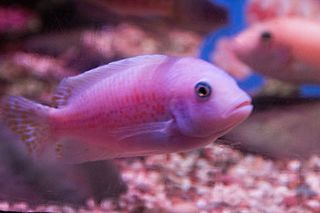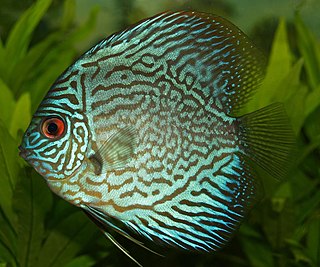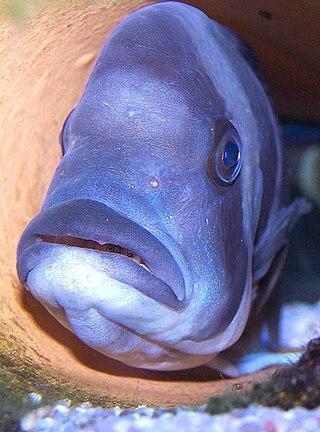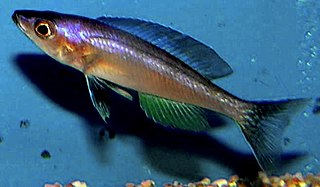
Cichlids are fish from the family Cichlidae in the order Cichliformes. Traditionally Cichlids were classed in a suborder, the Labroidei, along with the wrasses (Labridae), in the order Perciformes, but molecular studies have contradicted this grouping. On the basis of fossil evidence, it first appeared in Tanzania during the Eocene epoch, about 46–45 million years ago. The closest living relative of cichlids is probably the convict blenny, and both families are classified in the 5th edition of Fishes of the World as the two families in the Cichliformes, part of the subseries Ovalentaria. This family is large, diverse, and widely dispersed. At least 1,650 species have been scientifically described, making it one of the largest vertebrate families. New species are discovered annually, and many species remain undescribed. The actual number of species is therefore unknown, with estimates varying between 2,000 and 3,000.

Symphysodon is a genus of cichlids native to the Amazon river basin in South America. Due to their distinctive shape, calm behavior, many bright colors and patterns, and dedicated parenting techniques, discus are popular as freshwater aquarium fish, and their aquaculture in several countries in Asia is a major industry. They are sometimes referred to as pompadour fish. The discus fish has attracted a cult following of collectors and has created a multimillion dollar international industry complete with shows, competitions, and reputable online breeders.

Lake Tanganyika is an African Great Lake. It is the second-oldest freshwater lake in the world, the second-largest by volume, and the second-deepest, in all cases after Lake Baikal in Siberia. It is the world's longest freshwater lake. The lake is shared among four countries—Tanzania, the Democratic Republic of the Congo (DRC), Burundi, and Zambia, with Tanzania (46%) and DRC (40%) possessing the majority of the lake. It drains into the Congo River system and ultimately into the Atlantic Ocean.

Mouthbrooding, also known as oral incubation and buccal incubation, is the care given by some groups of animals to their offspring by holding them in the mouth of the parent for extended periods of time. Although mouthbrooding is performed by a variety of different animals, such as the Darwin's frog, fish are by far the most diverse mouthbrooders. Mouthbrooding has evolved independently in several different families of fish.

Crenicichla is a genus of cichlids native to South America commonly known as the pike cichlids. They are found in most tropical and subtropical freshwater habitats between the Andes and the Atlantic.

Aulonocara is a genus of haplochromine cichlids endemic to Lake Malawi in East Africa. All Aulonocara species are maternal mouth brooders. Particularly in the aquarium hobby, Aulonocara species are also known as peacock cichlids, aulonocaras or simply "peacocks". This genus is strongly sexually dichromic, even by haplochromine standards.
Ethelwynn Trewavas was an ichthyologist at the British Museum of Natural History. She was known for her work on the families Cichlidae and Sciaenidae. She worked with Charles Tate Regan, another ichthyologist and taxonomist.

Cyprichromis is a genus of cichlids with five species. They are also known as the herring cichlids or sardine cichlids, since they form large schools in the open water of Lake Tanganyika. Of the known species, only C. microlepidotus has been recorded outside Lake Tanganyika.

Steatocranus is a genus of small rheophilic cichlids mostly native to the Congo River Basin in DR Congo/Congo Brazzaville, although one species, S. irvinei, is restricted to the Volta River in Ghana and Burkino Faso, and it belongs in a separate genus. There are also at least c. 10 undescribed species in the Congo River basin awaiting scientific description.
Caprichromis is a small genus of haplochromine cichlids endemic to Lake Malawi in East Africa. This genus contains noted paedophagous cichlids, specialising in the eating of eggs and fry of other cichlid species.

Tilapia is a genus of cichlid fishes endemic to freshwater habitats in Southern Africa. In the past this was a very large genus including all species with the common name tilapia, but today the vast majority are placed in other genera.

Nannacara is a genus of small freshwater cichlid fish endemic to South America. The genus is part of the Cichlasomatini tribe of the Cichlasomatinae subfamily. In the aquarium hobby, the fish is considered a dwarf cichlid along with Apistogramma, Mikrogeophagus, and Dicrossus species. Nannacara anomala is the most commonly encountered species in the aquarium trade.

Hoplarchus is a genus of cichlid in the tribe Heroini. It contains the single species Hoplarchus psittacus, which is endemic to the blackwater rivers in Brazil, Colombia and Venezuela, including the Rio Negro, Jamari, Preto da Eva, Urubu rivers and upper Orinoco drainages. This fish can reach a length of 35 centimetres (14 in) TL and is important as a food fish to local indigenous peoples. This species is occasionally kept as an aquarium fish and is traded under the common name "parrot cichlid".

Heterochromis is a genus of cichlid fish in the order Perciformes. It is the only genus of the subfamily Heterochromidinae, and contains a single species, Heterochromis multidens, which is endemic to the Congo River Basin in Central Africa. The relationships of Heterochromis to other cichlids have long been controversial, with several morphological features suggesting that it is more closely related to American cichlids than to other African species. Molecular studies have given contradictory results. The most comprehensive analysis done to date found more support for relationship to African cichlids, but could not conclusively reject a relationship to the American clade.

Mesonauta, the flag cichlids, is a small genus of cichlids native to the Amazon, Orinoco, Essequibo, Paraná and Paraguay basins in South America. Mesonauta is included in the subfamily Cichlasomatinae. They occur in various freshwater habitats such as streams and lakes, especially in areas with little water movement and aquatic vegetation. They are generally found in small groups that stay near the water surface. To avoid predators, adults may jump out of the water and juveniles mimic leaves.
Interochromis loocki is a species of cichlid endemic to Lake Tanganyika in East Africa. It is a widespread but rare species living on rocky substrates in 2–3 m (7–10 ft) of water. This species can reach a length of 10.5 centimetres (4.1 in) TL. It is currently the only known member of its genus.

Paretroplus is a genus of fishes in the cichlid family, all of which are endemic to lakes and rivers of Madagascar. The vast majority are threatened and restricted to the northwestern part of the island. Only P. polyactis is found in the southern half of Madagascar and only P. polyactis and P. gymnopreopercularis are found in eastern drainages. Most are restricted to freshwater, but at least P. polyactis and P. maromandia can also be seen in brackish habitats.

The Pseudocrenilabrinae are a subfamily in the cichlid family of fishes to which, according to a study from 2004, includes all the Middle Eastern and African cichlids with the exception of the unusual Heterochromis multidens and the Malagasy species. This subfamily includes more than 1,100 species. Previous authors recognized additional African subfamilies, e.g. the Tilapiinae of Hoedeman (1947), Tylochrominae of Poll (1986), or Boulengerochrominae of Tawil (2001).

Ptychochromis insolitus, also known as the Mangarahara cichlid or joba mena, is a species of cichlid endemic to certain river systems in northern Madagascar. This critically endangered fish is threatened by habitat loss and competition from introduced species; after the last-known female was killed during a breeding attempt, its conservation received significant international attention as London Zoo launched a media campaign to identify any remaining individuals. A remnant population was discovered by aquaculture entrepreneur Guy Tam Hyock in 2013, and breeding programs in Madagascar and at Toronto Zoo have resulted in thousands of successful hatchlings.

Cichliformes is an order of fishes. Its members were previously classified under the order Perciformes, but now many authorities consider it to be an independent order within the subseries Ovalentaria.
















